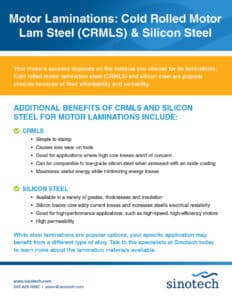The materials you choose for a motor lamination are one of the most important considerations of the motor design process. While there is no one go-to material for the essential motor component, some of the most popular options are cold rolled motor lamination steel (CRMLS) and silicon steel because of their versatility. By knowing the benefits of the materials and their applications, you’ll have a better idea if either is right for your custom motor components.
The Purpose of Motor Laminations
DC motors have an iron core within a ring. As the core rotates within the motor’s magnetic field, it generates voltage within the coils, producing an eddy current.
An eddy current is a type of magnetic loss. Eddy current losses results in power losses. Several factors affect how an eddy current flow contributes to power losses, such as the electromagnetic field, the magnetic material’s thickness, and the magnetic flux’s density.
A material’s resistance to current flows affects how eddy currents develop. When the material is too thick, for instance, the cross-sectional area increases, resulting in eddy current losses. For this reason, it may be necessary to use thinner materials to minimize the cross-sectional area.
To keep the materials thinner, manufacturers use several thin pieces called laminations to make up the armature cores. Unlike thick pieces, thinner pieces generate higher resistance, which leads to fewer eddy currents.
Laminations are made from a variety of alloys of electrical steel. Manufacturers stamp sheets of electrical steel into the desired shape using a press. Custom motors are made up of lam stacks, a stack of laminations. CRMLS and silicon steel are ideal for applications that don’t require the material to withstand high temperatures.
CRMLS vs. Silicon Steel Laminations
CRMLS
One of the lowest-cost materials for volume applications, cold rolled lamination steel is one of the most popular alloys. The material is simple to stamp and produces less wear on stamping tools compared to other materials. You may ask a custom motor manufacturer to anneal CRMLS with an oxide coat that adds inter-laminar resistance, making it comparable to low-grade silicon steel.
The difference between CRMLS and a cold rolled steel sheet is the composition of the steel and processing modifications, such as annealing.
CRMLS Applications
- Instances where high core losses are acceptable (e.g., low duty cycles, DC pole pieces)
- Large and small electric motors
- Generators
- Transformers
- Home appliances
- Ballasts
Silicon Steel
Also known as electrical steel, silicon steel is low-carbon steel with small amounts of silicon added to reduce core eddy current losses. Silicon protects the core of a stator and transformer and reduces the material’s hysteresis. Hysteresis is the time between when the magnetic field is initially generated and when it fully develops. Once cold-rolled and oriented appropriately, the material is ready for lamination applications. In general, both sides of silicon steel laminations are insulated and positioned on top of one another to reduce eddy currents. Addling silicon to the alloy has a notable impact on the life of stamping tools and dies.
Silicon steel is available in a variety of thicknesses and grades, allowing you to tailor the material for your specific application. The best type depends on allowable core losses in watts per pound. It is important to note that each grade and thickness affect the alloy’s surface insulation, longevity of the stamping tool, and the life of the die.
Like CRMLS, annealing helps strengthen silicon steel. After stamping, the annealing process relieves stress as it eliminates excess carbon. Depending on the type of silicon steel used, the component may need additional processing to further relieve stress. Because of the variety of choices in insulation, grades and thicknesses, it’s best to work with an engineer or designer who can help you weigh the benefits and drawbacks of the options available.
Silicon Steel Lamination Applications
- Motion-control products that require increased performance
- High-performance parts
- Generators
- Small and large motors
- Transformers
- Pole pieces
- Reactors
- Continuous-duty, high-efficiency rotating machinery
- Corrosion control
The material you select is one of the most important decisions you’ll make for your motor components. Leave guesswork out of the equation and let the experts at Sinotech help you determine the best alloys for your applications. We produce laminations out of several materials and gladly accommodate complex geometries. If all you need are lam stacks for your application, our factories are happy to custom-make them for you. Learn more about laminations for your custom motor components.


